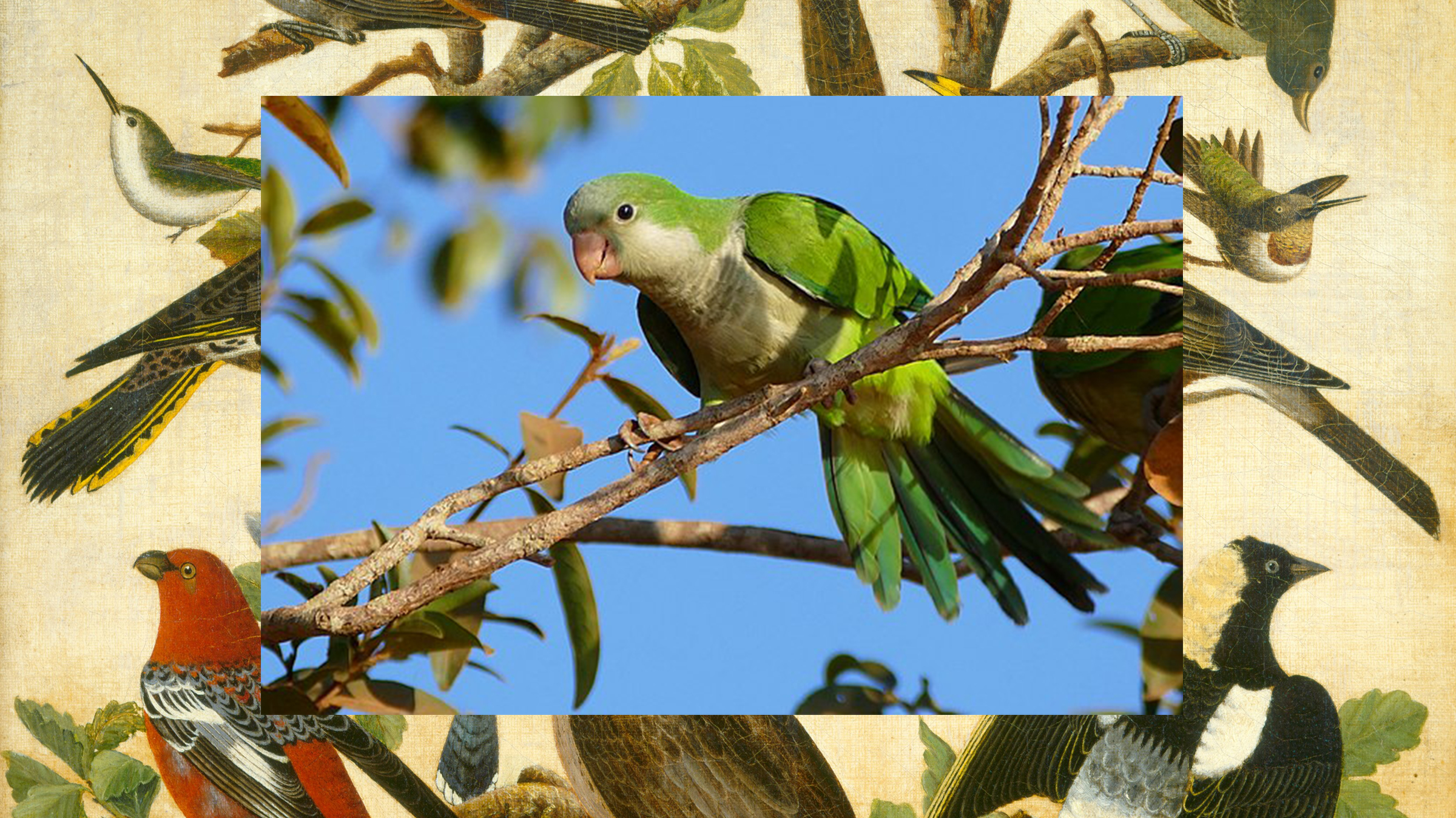Pets as Invasive Species: Birds, Feathered Friend or Foe?

Monk Parakeet (Photo: Bernard Dupont-Creative Commons Attribution-Share Alike 2.0 Generic license)
Birds are another beloved pet, adored for their plumage, their song, and for their interesting behavior. My own parakeets, Ernesto and Clyde, never fail to amuse with their head bobbing and love of stick-chewing. But like many pets that end up in the wild, either through accident or on purpose, some pet birds become invasive.
You’ve probably seen an invasive pet bird here in Austin. The beloved Monk Parakeet (Myiopsitta monachus), sometimes also called “Monk Parrot” or “Quaker Parakeet,” chattering away on power lines and cell phone towers. Plenty of articles on this bird exist, probably due in no small part to its prevalence across the US, as well as its charm. There is even a mural here in Austin honoring the bird.
The Monk Parakeet was introduced to the US in the 1950s and 1960s from South America through the exotic pet trade. Cliff Shackelford, an ornithologist for the Texas Parks and Wildlife Department, started monitoring the birds in Austin in the late 1990s. He speculates 19 monk parakeets were intentionally released in the 1980s near Zilker Park, and the current population descends from that colony. However, as it’s next to impossible to know who might have released these birds, their entry to Austin still remains unknown.
Monk Parakeets are very hardy and can survive a wide temperature range, allowing them to adapt to many different US cities. Some of these cities include New Orleans, Portland, Miami, and even Chicago! The fact that many Austin populations of the Monk Parakeet survived the historic 2021 winter storm Uri attests to their remarkable tolerance to weather extremes.
Monk Parakeets survive cold weather by building large elaborate nests where several mating pairs live. These nests are massive creations, weighing up to 400 pounds, high up in cell phone towers and utility poles. UT’s intramural fields had several nests in the field light towers before the lights were replaced, displacing the nests.
When nests are displaced, Austin Energy follows strict protocol to avoid harming the birds, chicks, or eggs. This attentive treatment of the Monk Parakeet is followed in other parts of the country, with states like New Jersey and New York proposing laws to protect the bird.
Initial worry about Monk Parakeets being invasive was that they could become an agriculture pest. However, they have not yet been observed to do what was feared. The damage they do is to electrical lines and utility poles which can cause power outages. The nests can also catch fire because of their proximity to wires. Beyond this, more research needs to be done to establish what other environmental damage, if any, Monk Parakeets have caused.

Yellow-Crested Cockatoo (Photo: Charles Lam. Creative Commons Attribution-Share Alike 2.0 Generic license.
There is another example of a pet bird with a somewhat similar story as that of the Monk Parakeets. This is not one we see flying around Austin, but one just as noticeable and loved as the Monk Parakeet. This is the Yellow-Crested Cockatoo (Cacatua sulphurea), native to Indonesia and East Timor. Communities of escaped or released feral cockatoos exist in China and Hong Kong. Their numbers in Hong Kong are estimated to be around 200. Word is the colonial governor in 1941 released these pet birds on the eve of the Japanese invasion, and the current colonies descend from these birds. However, without any evidence to support this, this story is most likely just urban lore.
These birds are popular as pets for their beautiful plumage and intelligence. But this popularity has come at a price: decimation of wild populations. Between 1981-1993, approximately 80,000 were removed from their native habitats to be sold by the pet trade. Logging practices have also reduced their native habitat which has further exacerbated the decline. Now, there are less than 2500 known individuals remaining in the wild.
When the cockatoo populations began to grow in Hong Kong, some people considered the bird a pest and feared it would destroy trees. However, the government determined in the mid 1980s that the damage was negligible. In Hong Kong currently, the feral populations are protected by laws which help their populations there.
This bird is in a unique situation when it comes to feral verses wild populations, and provides an interesting twist to what is typically understood about invasive species. Some studies suggest that urban populations of Yellow-Crested Cockatoos can help rebuild their own critically-endangered populations in the wild. How? Some feral cockatoos can be captured and released back into their native environments to help increase the population. However, in the wild, this attempt only works if their native environments are protected from the factors that decimated their populations in the first place.
For now, the small number in Hong Kong seems to be doing well, free from the issues that plague their native populations.
Check out our other blogs on pets as invasive species! Intro blog is here. Then take a look at cats and fish. Not to be outdone are reptiles and amphians and fish.
SOURCES
Elegant, Naomi Xu, “Could Hong Kong’s Fugitive Cockatoos Save the Species.” Atlas Obscura. September 24, 2021. (https://www.atlasobscura.com/articles/hong-kong-cockatoos-conservation)
Lewis, Danny. “How Escaped Exotic Pet Birds Could Help Save Threatened Species” Smithsonian Magazine, January 16, 2017.
Potucek, Jan. “Critically endangered Yellow-crested Cockatoos nest in Hong Kong skyscrapers.” February 12, 2017. Parrots - Dailynews.com (https://www.parrotsdailynews.com/critically-endangered-yellow-crested-cockatoos-nest-in-hong-kong-among-skyscrapers/)
Tamplin, Harley. “ ‘I think they did take a hit’: Austin’s famous wild monk parakeets bouncing back after brutal winter storms.” KXAN. September 22, 2021. (https://www.kxan.com/news/local/austin/i-think-they-did-take-a-hit-austins-famous-wild-monk-parakeets-bouncing-back-after-brutal-winter-storms/)
Texas Invasive Species Institute: Monk Parrot. (http://www.tsusinvasives.org/home/database/myiopsitta-monachus)
The Cornell Lab: All About Birds. “Monk Parakeets.” (https://www.allaboutbirds.org/guide/Monk_Parakeet/overview#https://www.allaboutbirds.org/guide/Monk_Parakeet/overview#)
Wood, Matt. “Escaped pet parrots are now naturalized in 23 U.S. states, study finds.” University of Chicago Medicine. May 13, 2019. (https://www.uchicagomedicine.org/forefront/biological-sciences-articles/es caped-pet-parrots-naturalized-in-23-states)



